Quantum Volume#
Quantum Volume (QV) is a single-number metric that can be measured using a concrete protocol on near-term quantum computers of modest size. The QV method quantifies the largest random circuit of equal width and depth that the computer successfully implements. Quantum computing systems with high-fidelity operations, high connectivity, large calibrated gate sets, and circuit rewriting toolchains are expected to have higher quantum volumes. See the Qiskit Textbook for an explanation on the QV method, which is described in Refs. [1] [2].
The Quantum Volume is determined by the largest successful circuit depth
\(d_{max}\), and equals to \(2^{d_{max}}\). In this experiment,
we generate QV circuits using the qiskit.circuit.library.QuantumVolume class
on \(d\) qubits, which contain \(d\) layers, where each layer
consists of random 2-qubit unitary gates from \(SU(4)\), followed by
a random permutation on the \(d\) qubit. Then these circuits run on
the quantum backend and on an ideal simulator (either qiskit_aer.AerSimulator
or qiskit.quantum_info.Statevector).
A depth \(d\) QV circuit is successful if it has mean heavy-output probability > 2/3 with confidence level > 0.977 (corresponding to z_value = 2), and at least 100 trials have been ran.
Note
This tutorial requires the qiskit-aer and qiskit-ibm-runtime
packages to run simulations. You can install them with python -m pip
install qiskit-aer qiskit-ibm-runtime.
from qiskit_experiments.framework import BatchExperiment
from qiskit_experiments.library import QuantumVolume
# For simulation
from qiskit_aer import AerSimulator
from qiskit_ibm_runtime.fake_provider import FakeSydneyV2
backend = AerSimulator.from_backend(FakeSydneyV2())
QV experiment#
To run the QV experiment we need need to provide the following QV parameters, in order to generate the QV circuits and run them on a backend and on an ideal simulator:
qubits: The number of qubits or list of physical qubits for the experiment.trials: The number of trials to run the quantum volume circuit (the default is 100).seed: Seed or generator object for random number generation. IfNonethendefault_rngwill be used.simulation_backend: The simulator backend to use to generate the expected results. the simulator must have asave_probabilitiesmethod. If None,AerSimulatorwill be used (in caseAerSimulatoris not installed,Statevectorwill be used).
Note: In some cases, 100 trials are not enough to obtain a QV greater than 1 for the specified number of qubits. In this case, adding more trials may reduce the error bars to allow passing the threshold.
The analysis results of the QV Experiment are:
The mean heavy-output probabilities (HOP) and standard deviation
The calculated quantum volume, which will be None if the experiment does not pass the threshold
Extra data included in the analysis results includes
The heavy HOPs for each trial
Confidence level (should be greater than 0.977)
The number of trials and depth of the QV circuits
Whether the QV circuit was successful
qubits = tuple(range(4)) # Can use specific qubits. for example [2, 4, 7, 10]
qv_exp = QuantumVolume(qubits, seed=42)
# Transpile options like optimization_level affect only the real device run and not the simulation run
# Run options affect both simulation and real device runs
qv_exp.set_transpile_options(optimization_level=3)
# Run experiment
expdata = qv_exp.run(backend).block_for_results()
# View result data
display(expdata.figure(0))
for result in expdata.analysis_results():
print(result)
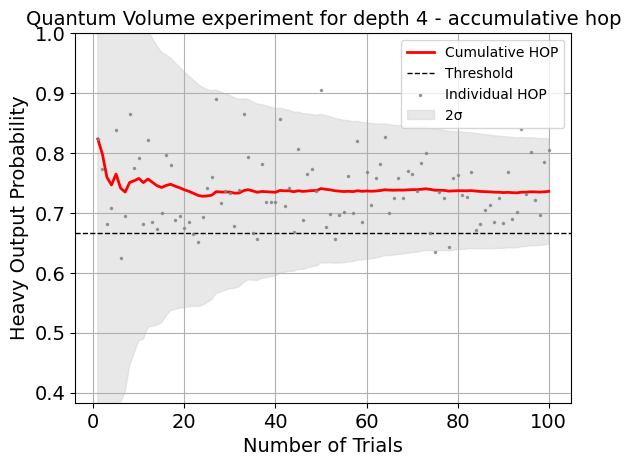
AnalysisResult
- name: mean_HOP
- value: 0.74+/-0.04
- quality: bad
- extra: <8 items>
- device_components: ['Q0', 'Q1', 'Q2', 'Q3']
- verified: False
AnalysisResult
- name: quantum_volume
- value: 1
- quality: bad
- extra: <8 items>
- device_components: ['Q0', 'Q1', 'Q2', 'Q3']
- verified: False
# Print extra data
for result in expdata.analysis_results():
print(f"\n{result.name} extra:")
for key, val in result.extra.items():
print(f"- {key}: {val}")
mean_HOP extra:
- HOPs: [0.8232421875, 0.7734375, 0.681640625, 0.7080078125, 0.837890625, 0.6240234375, 0.6953125, 0.8642578125, 0.775390625, 0.7919921875, 0.6806640625, 0.822265625, 0.6845703125, 0.6728515625, 0.7001953125, 0.796875, 0.779296875, 0.6884765625, 0.6953125, 0.6748046875, 0.6845703125, 0.6650390625, 0.6513671875, 0.693359375, 0.7421875, 0.759765625, 0.890625, 0.716796875, 0.736328125, 0.732421875, 0.6787109375, 0.73828125, 0.8642578125, 0.7939453125, 0.666015625, 0.65625, 0.7822265625, 0.71875, 0.7177734375, 0.7177734375, 0.857421875, 0.7119140625, 0.7412109375, 0.66796875, 0.806640625, 0.6875, 0.765625, 0.7734375, 0.7373046875, 0.904296875, 0.6767578125, 0.6982421875, 0.65625, 0.697265625, 0.7021484375, 0.7607421875, 0.7001953125, 0.8203125, 0.6845703125, 0.767578125, 0.712890625, 0.7578125, 0.7822265625, 0.826171875, 0.7001953125, 0.724609375, 0.7587890625, 0.7255859375, 0.76953125, 0.7646484375, 0.736328125, 0.783203125, 0.7998046875, 0.666015625, 0.634765625, 0.734375, 0.7255859375, 0.642578125, 0.7587890625, 0.763671875, 0.7294921875, 0.7265625, 0.7685546875, 0.671875, 0.681640625, 0.705078125, 0.712890625, 0.685546875, 0.724609375, 0.6826171875, 0.767578125, 0.689453125, 0.701171875, 0.83984375, 0.7314453125, 0.8017578125, 0.7216796875, 0.6962890625, 0.7841796875, 0.8046875]
- two_sigma: 0.08817177200919772
- depth: 4
- trials: 100
- success: None
- confidence: None
- experiment: QuantumVolume
- run_time: None
quantum_volume extra:
- HOPs: None
- two_sigma: None
- depth: 4
- trials: 100
- success: False
- confidence: 0.9418113449536769
- experiment: QuantumVolume
- run_time: None
Adding trials#
Adding more trials may reduce the error bars to allow passing the threshold (beside the error bars - QV experiment must have at least 100 trials to be considered successful). In case you want to add less than 100 additional trials, you can modify the amount of trials added before re-running the experiment.
qv_exp.set_experiment_options(trials=60)
expdata2 = qv_exp.run(backend, analysis=None).block_for_results()
expdata2.add_data(expdata.data())
qv_exp.analysis.run(expdata2).block_for_results()
# View result data
display(expdata2.figure(0))
for result in expdata2.analysis_results():
print(result)
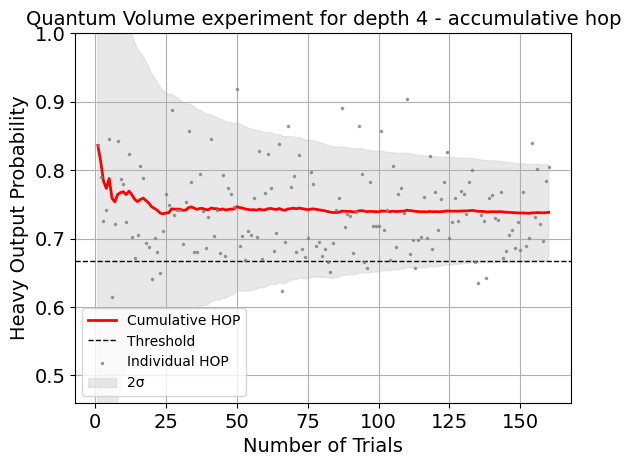
AnalysisResult
- name: mean_HOP
- value: 0.738+/-0.035
- quality: good
- extra: <8 items>
- device_components: ['Q0', 'Q1', 'Q2', 'Q3']
- verified: False
AnalysisResult
- name: quantum_volume
- value: 16
- quality: good
- extra: <8 items>
- device_components: ['Q0', 'Q1', 'Q2', 'Q3']
- verified: False
Calculating Quantum Volume using a batch experiment#
Run the QV experiment with an increasing number of qubits to check what is the maximum Quantum Volume for the specific device. To reach the real system’s Quantum Volume, one must run more trials and additional enhancements might be required (See Ref. [2] for details).
exps = [QuantumVolume(tuple(range(i)), trials=200) for i in range(3, 6)]
batch_exp = BatchExperiment(exps)
batch_exp.set_transpile_options(optimization_level=3)
# Run
batch_expdata = batch_exp.run(backend).block_for_results()
Extracting the maximum Quantum Volume.
qv_values = [
batch_expdata.child_data(i).analysis_results("quantum_volume").value
for i in range(batch_exp.num_experiments)
]
print(f"Max quantum volume is: {max(qv_values)}")
Max quantum volume is: 8
for i in range(batch_exp.num_experiments):
print(f"\nComponent experiment {i}")
sub_data = batch_expdata.child_data(i)
display(sub_data.figure(0))
for result in sub_data.analysis_results():
print(result)
Component experiment 0
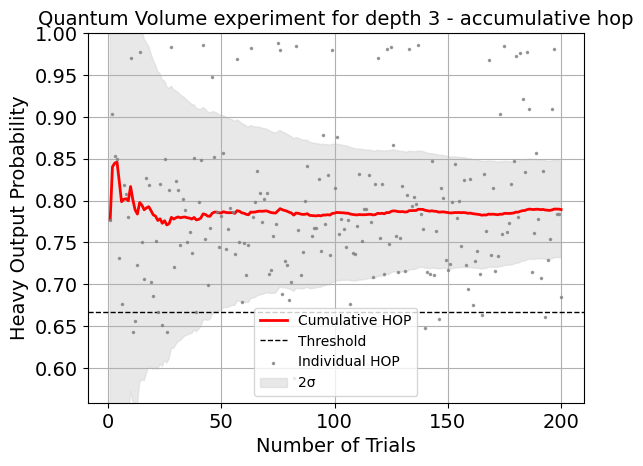
AnalysisResult
- name: mean_HOP
- value: 0.789+/-0.029
- quality: good
- extra: <8 items>
- device_components: ['Q0', 'Q1', 'Q2']
- verified: False
AnalysisResult
- name: quantum_volume
- value: 8
- quality: good
- extra: <8 items>
- device_components: ['Q0', 'Q1', 'Q2']
- verified: False
Component experiment 1
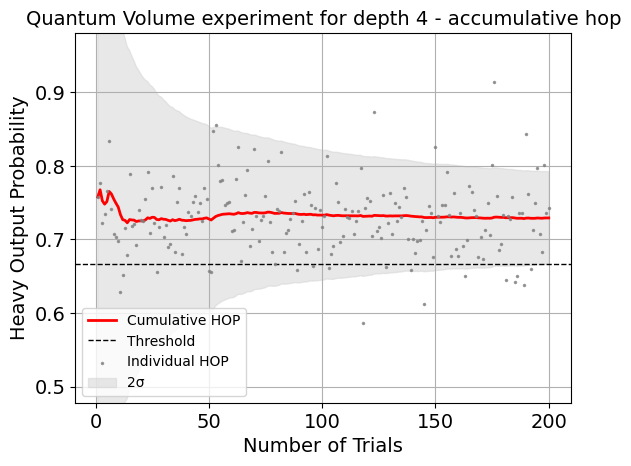
AnalysisResult
- name: mean_HOP
- value: 0.729+/-0.031
- quality: bad
- extra: <8 items>
- device_components: ['Q0', 'Q1', 'Q2', 'Q3']
- verified: False
AnalysisResult
- name: quantum_volume
- value: 1
- quality: bad
- extra: <8 items>
- device_components: ['Q0', 'Q1', 'Q2', 'Q3']
- verified: False
Component experiment 2
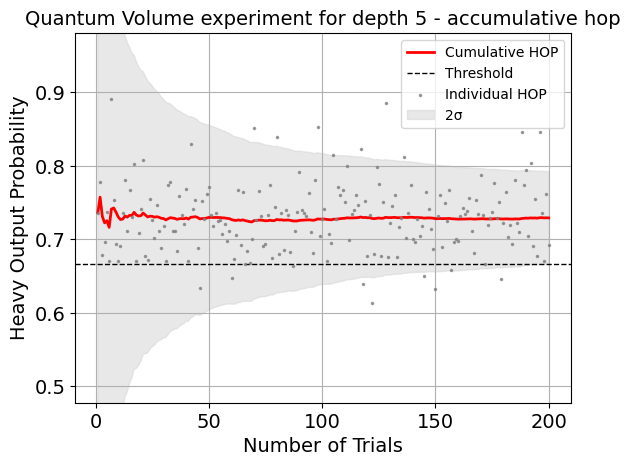
AnalysisResult
- name: mean_HOP
- value: 0.729+/-0.031
- quality: bad
- extra: <8 items>
- device_components: ['Q0', 'Q1', 'Q2', 'Q3', 'Q4']
- verified: False
AnalysisResult
- name: quantum_volume
- value: 1
- quality: bad
- extra: <8 items>
- device_components: ['Q0', 'Q1', 'Q2', 'Q3', 'Q4']
- verified: False
References#
See also#
API documentation:
quantum_volumeQiskit Textbook: Measuring Quantum Volume